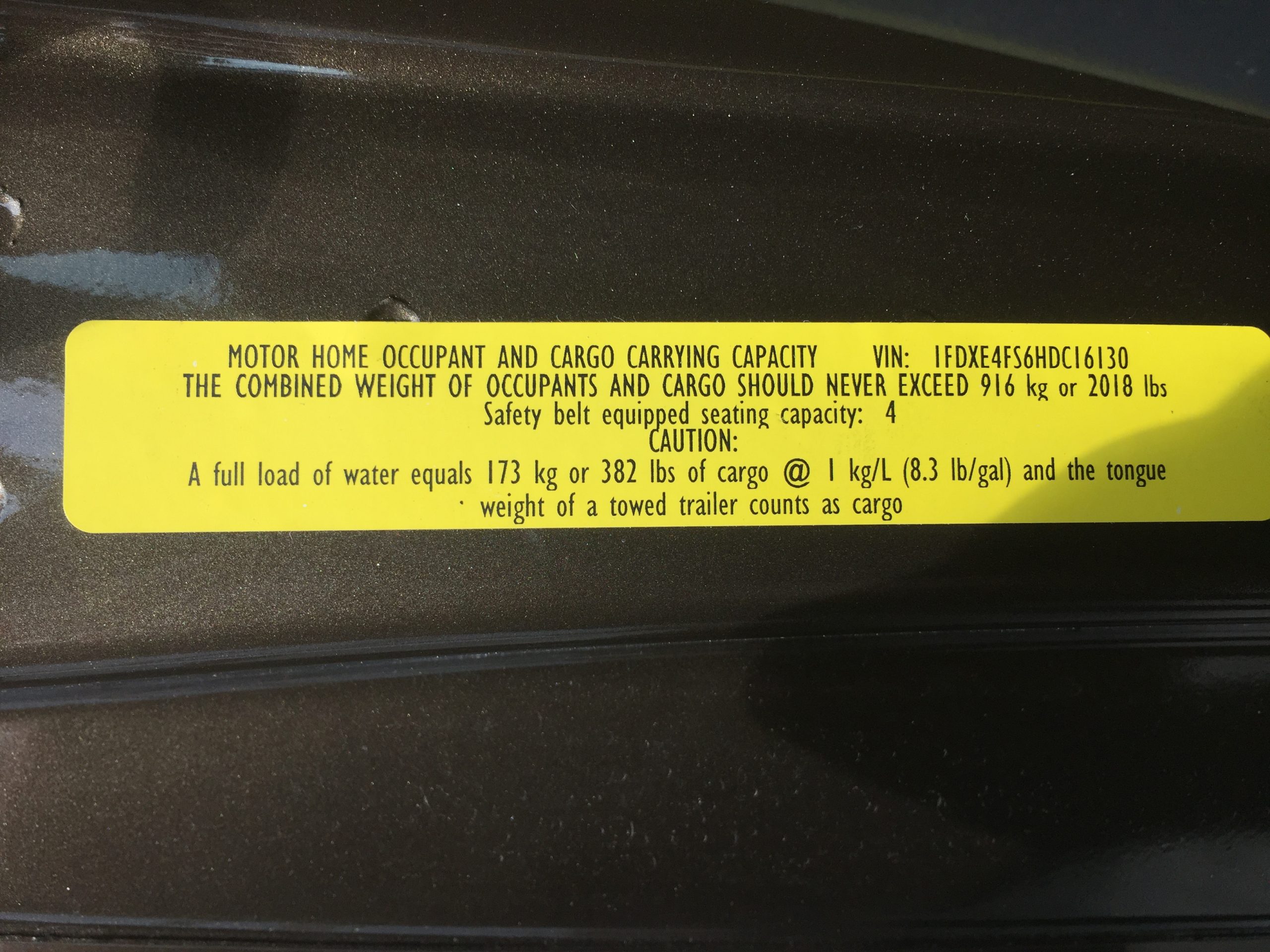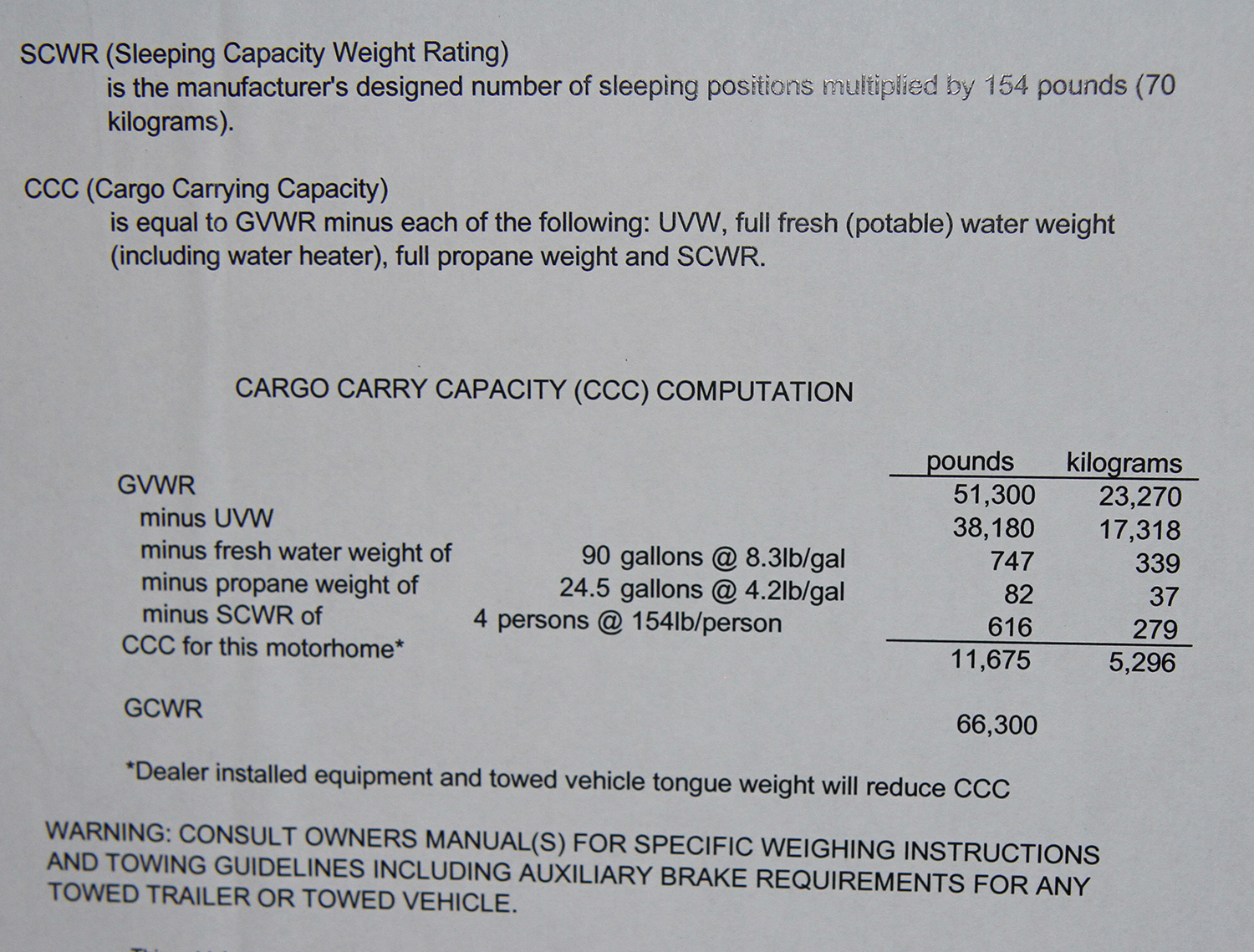Every RV has specific ratings, limits and capacities related to weight distibution.
We’ve all heard the saying – “It just looks like his number was up”. Well motorhomes have numbers too – lots of them in fact, which can be a bit confusing to a prospective RV buyer. It’s easy to view a spec sheet or brochure and understand how large the holding tanks are, how many gallons the fuel tank holds or how many BTUs the furnace puts out, but there is a wide array of chassis-related numbers that may take a while to grasp their meanings. Once you have narrowed down whether you want gas or diesel, a Class A or Class C and the approximate length you want, it’s important to understand the various weight ratings to ensure that the RV you are choosing is capable of operating safely within its design parameters. Following is a summary of those ratings that will help you to better understand what they mean.
Gross Vehicle Weight Rating (GVWR)
The Gross Vehicle Weight Rating, or GVWR, is usually the first number that anyone pays attention to on a motorhome. It represents just how big this RV is. In actuality, it represents how heavy an RV can be within safe design parameters – so it’s really a “not to exceed” weight rating. Every motorhome is designed with a chassis frame, tires, engine, suspension, brakes, transmission and other components to operate in a given environment. A heavier vehicle will have stronger components to prevent failure at higher weight loads and deliver satisfactory performance when in operation. If you load your coach up with full cargo, occupants, full fuel and water the total weight should not exceed the GVWR. This is why it’s important to weigh your coach when fully loaded to ensure that you do not exceed the GVWR of that motorhome. Note that this is the resting weight and does not count any towed vehicles or trailers other than the amount of any tongue weight resting on the hitch. Although, if you have a motorcycle carrier or golf cart mounted on your trailer hitch that weight may be a significant amount.
Unloaded Vehicle Weight (UVW)
The Unloaded Vehicle Weight, or UVW, represents the actual weight of the vehicle when empty as it left the factory. You may see this listed on some manufacturer brochures or webpages but keep in mind these are generalizations and your actual will vary according to what options are chosen on your coach. Your vehicle’s actual UVW will be shown on a placard within the motorhome. The UVW includes a full tank of fuel and any chassis related fluids, such as coolant and oil, but does not include any water or propane. Once you know your RV’s GVWR and the UVW, you can calculate the CCC.
Sleeping Capacity Weight Rating (SCWR)
The Sleeping Capacity Weight Rating, or SCWR, is calculated by multiplying the number of sleeping positions by 154 pounds. Every coach will state how many sleeping positions are in the coach. The RVIA came up with 154 lbs. as an average number. The SCWR number isn’t all that important any more, as we’ll see later.
Cargo Carrying Capacity (CCC)
The Cargo Carrying Capacity, or CCC, represents how much stuff you can carry. It’s calculated by subtracting the UVW from the GVWR and then subtracting the SCWR, weight of the fresh water in your coach and the weight of the propane. The end result is the cargo carrying capacity.
It’s not the most useful because the SCWR is an arbitrary number at best. CCC is still used in towable RVs but is no longer used in motorhomes, being replaced by OCCC.
Occupant and Cargo Carrying Capacity (OCCC)
Occupant and Cargo Carrying Capacity, or OCCC, has been used in motorized RVs since 2008. It includes the weight of occupants, water and propane as well. If you have a pair of 250 lb. persons in their coach, a full tank of water (100 gallons equals 834 lbs.) and 100 lbs. of propane on board you’ll already have 1,434 lbs. used up and you haven’t yet loaded up any food, clothing or recreational equipment. Some motorhomes may only have a couple of thousand pounds of cargo capacity while some of the large tag axle coaches may have over 10,000 lbs. It’s definitely something you need to consider and compare to your traveling habits when buying a motorhome.
This example shows the OCCC as well as defining the weight of water used in its calculation.
Gross Axle Weight Rating (GAWR)
The Gross Axle Weight Rating, or GAWR, is a weight rating of an axle. You’ll have both a front axle GAWR as well as a rear axle GAWR. If you have a tag axle coach, you’ll also have a tag axle GAWR. Most of the time your two or three axle ratings will add up to the GVWR but that is not always the case. In some cases an axle may be rated higher but the GVWR of the coach itself will be less due to limitations of the suspension, brakes, etc.
GAWRs come into play in regard to weight distribution. You may have a coach that is loaded up to the full GVWR, but if the cargo weight isn’t distributed evenly you may have one axle overweight while the other end of the coach is lightly loaded. This can lead to excessive stress on the suspension components and tires that are overloaded. This underscores the importance of having your motorhome weighed on scales when fully loaded. Ideally, you should have a 4-corner weighing at a facility such as National Indoor RV Centers. That will show you if you have any side-to-side imbalance where you may need to shift some cargo from one side to the other. But if that’s not possible, at least have a per-axle scale reading taken at a truck stop.
As a rule of thumb, single rear axle coaches tend to have most of the weight on the rear axle. The Federal Bridge Law limited the maximum weight of any axle to 20,000 lbs. This caused issues with the larger 37-40’ diesel pushers because all of the new amenities and ceramic tile floors added too much weight to the rear axle, leaving the front axle lightly loaded. Fortunately, the NHTSA changed the rules in 2008, allowing motorhomes to have higher axle rating. Currently most of the larger single-axle diesel pushers are equipped with upgraded 24K rated axles to restore some cargo capacity. If you have a tag axle coach, just the opposite is true. The addition of the tag axle gives you greater cargo capacity so you’ll be hard pressed to overload the rear axles on a tag axle coach. But the tag axle also acts as a fulcrum, shifting more weight to the front steer axle, which can cause it to exceed its GAWR. When looking to buy a tag axle coach, pay close attention to the GAWR on the front axle.,
A typical placard, this one from a 2007 Allegro Bus, showing GVWR, GCWR, CCC and SCWR.
RV Hitch Rating
Your trailer hitch should be stamped with a pair of ratings, although you might have crawl under the hitch to find it. The first is the tongue weight and the second is the rating of how much you can pull. Tongue weights aren’t a problem if you are flat towing with a towbar because the towbar merely acts as a connector between the two vehicles and the only weight that is applied to the motorhome is part of the weight of just the towbar. If you have a trailer you will need to check the tongue weight of that trailer when loaded to ensure that it doesn’t exceed what is stamped on the hitch. You may have to shift some of the trailer’s cargo rearward if excessive. If you utilize a hitch mounted carrier for a motorcycle lift, you’ll also need to ensure that your hitch is rated to carry that additional weight.
Gross Combined Weight Rating (GCWR)
The Gross Combined Weight Rating, or GCWR, is the total weight of the combination of motorhome and anything it is towing. The GCWR will exceed the GVWR by anywhere from 3,000 to 10,000 lbs. It’s not strictly an indication of how much you can tow but it is designed to prevent damage to the engine and its cooling system, the transmission and other components. If you are loaded up to the full GVWR when traveling, the difference between the GCWR and GVWR will be your maximum towing ability. If you are traveling at less than your GVWR, you can add those additional pounds to your towing rating. However, your ability to tow is limited by two factors.
First of all, the motorhome’s trailer hitch has a rating which you cannot exceed – so your towing capacity will be the least of either the hitch rating or the difference between the GCWR and GVWR. It’s like a chain where the weakest length determines how much the chain can lift. You may have a 5,000 lb. hitch with an 8,000 lb. GCWR/GVWR delta so you’ll be limited to 5,000 lbs. because the trailer hitch is the weakest point. Conversely, you may have a heavy-duty 20,000 lb. hitch on that vehicle, but you’ll still be limited to the 8,000 lb. delta between the GCWR and GVWR
Lastly, the GCWR is based upon having trailer brakes on your trailer. The brakes on the motorhome are not designed to safely bring your coach to a stop in the required distance when towing. Most RV owners prefer to tow four down with a tow bar so you will need to use a supplemental braking system with your towed vehicle.
Maximum Inflation Pressure (MIP)
Your tires have a Maximum Inflation Pressure, or MIP. The sidewall of the tire will designate the maximum inflation pressure as well how many pounds that tire is capable of supporting. Again, this is why it’s important to have your coach weighed on a four corner or per axle basis when fully loaded. Your tire manufacturer will have an inflation table for each specific size or tire that they make. This chart will tell you what the cold inflation pressure, or CIP, should be for that weight rating.
Once you have your coach weighed you can determine how much pressure is needed in your tires. If the tire is designed for more weight than what you will be carrying you don’t have to inflate it to the maximum inflation pressure. Reducing the pressure will give you a better ride and improve traction. It’s always good to run about 5 psi over what the chart states though to allow for any changes in the future. It also allows for a slight weight imbalance between the left and right tires. You must always use the same pressure on both tires on the same axle though, but you can have different pressures between the steer and drive axles. Always keep a minimum pressure of 85 PSI on large drive or tag axles tires to ensure the tire’s bead stays seated on the wheel rim.
By ensuring that all of these ratings are not exceeded you’ll be sure that you can safely operate your motorhome. Following is a list of links to inflation charts for RV tires from some of the major manufacturers:

Mark Quasius is the founder of RVtechMag.com, the past Midwest editor of RV Magazine, writes for numerous RV-related publications and a regular Contributor to FMCA’s Family RVing Magazine. Mark and his wife Leann travel in their 2016 Entegra Cornerstone.



